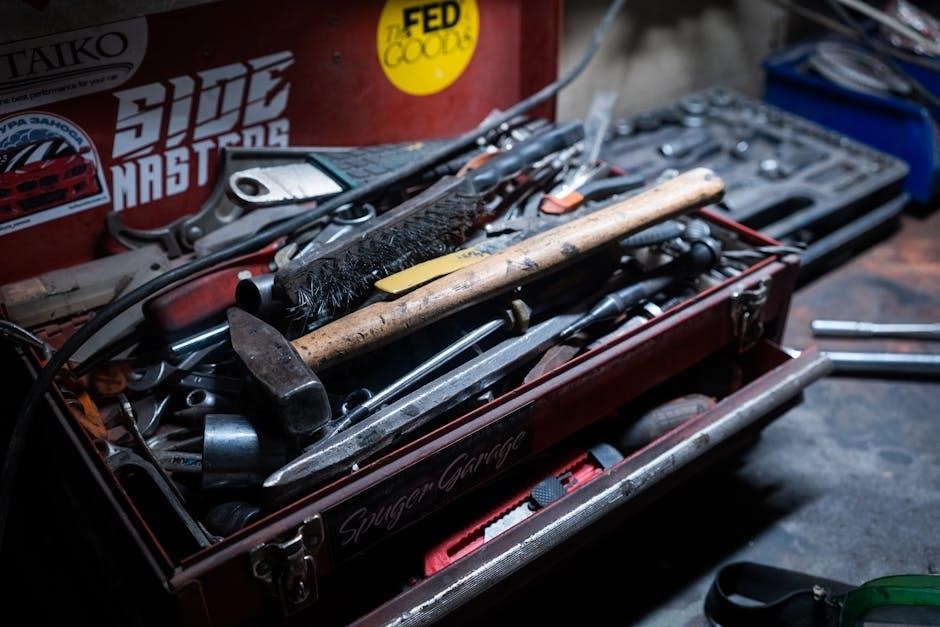Welcome to the Craftsman Snowblower Owner’s Manual, your comprehensive guide to safe operation, maintenance, and troubleshooting. This manual covers essential features, setup, and best practices for optimal performance.

1.1 Overview of the Manual’s Importance
The Craftsman Snowblower Owner’s Manual is a vital resource for ensuring safe, effective, and efficient operation of your snowblower; It provides detailed instructions for assembly, maintenance, and troubleshooting, helping you maximize performance while minimizing potential risks. The manual covers essential safety precautions, warranty information, and best practices for winter preparation and storage. By following the guidelines outlined, you can extend the lifespan of your snowblower and maintain its reliability. Whether you’re a new user or experienced operator, this manual serves as your go-to guide for understanding and caring for your Craftsman snowblower. Reading it thoroughly ensures you’re equipped to handle all aspects of ownership confidently.
1;2 Brief History of Craftsman Snowblowers
Craftsman, a trusted brand since 1927, has a long-standing reputation for producing durable and innovative tools. Their snowblowers, introduced in the mid-20th century, quickly became known for reliability and performance. Over the years, Craftsman snowblowers have evolved, incorporating advanced features like two-stage and three-stage systems, electric starts, and improved auger designs. This commitment to innovation has solidified their place as a leader in winter equipment, offering models that cater to various needs, from small driveways to heavy-duty snow removal. Today, Craftsman continues to be a preferred choice for homeowners and professionals alike, blending tradition with cutting-edge technology to tackle tough winter conditions effectively.

Safety Guidelines and Precautions
Always read the manual, wear protective gear, and ensure proper assembly. Avoid hazardous conditions, keep hands away from moving parts, and maintain a safe distance while operating.
2.1 General Safety Tips for Snowblower Operation
Always read and understand the owner’s manual before operating the snowblower. Wear protective gear, including gloves, safety glasses, and sturdy footwear. Ensure the area is clear of obstacles and keep children and pets away. Never operate the snowblower in enclosed spaces or without proper ventilation to avoid carbon monoxide exposure. Avoid wearing loose clothing that could get caught in moving parts. Be cautious on uneven or icy surfaces, as they can cause instability. Never touch the auger or impeller while the machine is running. Use the chute control responsibly to direct snow away from people and windows; If the snowblower stalls, turn it off and wait for all parts to stop before inspecting. Follow all safety guidelines to ensure a safe and effective snow-clearing experience.
2.2 Protective Gear Recommendations
Always wear appropriate protective gear when operating a Craftsman snowblower to minimize injury risks. Essential items include heavy-duty gloves to protect hands from cold and abrasions, safety glasses or goggles to shield eyes from debris, and sturdy, slip-resistant footwear with good traction. Dress in warm, layered clothing to withstand cold temperatures, and avoid loose clothing that could get caught in moving parts. Consider wearing a scarf or neck gown to protect against cold air. A hat and earmuffs can prevent heat loss and protect hearing from engine noise. Ensure all gear fits securely and does not obstruct visibility or movement. Proper protective equipment is crucial for safe and comfortable snowblower operation in harsh winter conditions.
2.3 Hazardous Situations to Avoid
When operating a Craftsman snowblower, avoid hazardous situations to ensure safety. Never wear loose clothing that could get caught in moving parts, and keep children and pets at a safe distance. Avoid operating the snowblower in poor visibility, such as darkness or heavy snowfall, as this increases the risk of accidents. Do not use the snowblower near open flames or sparks, as gasoline vapors can ignite. Never ingest flammable liquids or gases, and avoid operating the machine if under the influence of alcohol or drugs. Additionally, refrain from overreaching or leaning into the auger housing, as this can lead to serious injury. Always maintain a safe working area and follow all safety guidelines to minimize risks while operating your snowblower.

Assembly and Setup Instructions
Follow the manual carefully to ensure proper assembly and setup of your Craftsman snowblower. Begin by unboxing and verifying all hardware and tools are included; Always refer to the diagrams for accurate assembly and ensure all bolts and screws are securely tightened. Check the inventory list to confirm no parts are missing. Properly attach the chute, control, and auger housing as outlined. If unsure, consult the provided instructions or contact customer support for assistance. Safety precautions and correct assembly are crucial for optimal performance and longevity of your snowblower.
3.1 Unboxing and Inventory of Parts
Begin by carefully unboxing your Craftsman snowblower to ensure all components are accounted for. Check the packing list provided in the manual to verify the inclusion of all parts, such as the auger housing, chute, control panel, skid shoes, and hardware bag. Inspect each item for damage or defects. If any parts are missing or damaged, contact Craftsman customer support immediately. Organize the components neatly to avoid misplacement during assembly. Pay special attention to small hardware like bolts, nuts, and clips, as they are critical for proper assembly. Refer to the exploded diagrams in the manual to familiarize yourself with each part’s purpose and location. Ensure all tools required for assembly are readily available before proceeding.
3.2 Initial Assembly Steps
Start by assembling the handlebars and attaching them securely to the snowblower’s frame using the provided bolts. Tighten all connections firmly to ensure stability; Next, install the chute control by aligning it with the designated mounting points and securing it with the hairpin clip. Attach the skid shoes to the auger housing, adjusting their height as needed for optimal ground clearance. Ensure all moving parts, such as the auger and impeller, are properly aligned and free from obstructions. Refer to the exploded diagrams for precise guidance. Double-check that all fasteners are tightened to the recommended torque specifications to prevent loosening during operation. If unsure about any step, consult the manual or seek assistance to avoid assembly errors.
3.3 Attaching the Chute and Control
Attach the chute to the snowblower by aligning it with the mounting bracket on the auger housing. Secure it using the provided hardware, ensuring a tight fit to prevent snow leakage. Next, connect the chute control handle to the control head. Use the hairpin clip removed during assembly to lock the control in place. Adjust the chute directional cable by pulling it gently to ensure smooth rotation of the chute. Tighten all bolts and screws to avoid loosening during operation. Finally, test the chute control by rotating it to ensure proper alignment and movement. If the chute does not move freely, check the cable tension and adjust as needed. Proper installation ensures efficient snow discharge and precise control during use.
3.4 Setting Up the Auger Housing
Begin by ensuring the auger housing is securely attached to the snowblower’s frame using the bolts provided. Tighten them evenly to maintain balance. Install the auger blades, aligning them with the keyway slots inside the housing. Secure each blade with a shear pin and washer, ensuring they are properly seated to prevent vibration. Next, attach the skid shoes to the bottom of the auger housing. Adjust their height to suit the surface you’ll be clearing—raise them for smoother surfaces and lower them for uneven terrain. Finally, inspect the auger housing for any debris or obstructions. Proper setup ensures efficient snow intake and even distribution, optimizing the snowblower’s performance and longevity. Always refer to the manual for specific torque and alignment specifications.

Operating the Snowblower

Start the engine following the manual’s instructions, engage the auger, and adjust the chute direction. Maintain steady control and clear the area of obstacles for safe operation.
4.1 Starting the Engine
Ensure the snowblower is on a flat surface and clear of obstructions. Engage the choke by pulling the lever to the ‘start’ position. Press the primer bulb 3-4 times to prime the engine. Firmly pull the starter rope in a smooth motion until the engine starts. Once running, move the choke to the ‘run’ position and allow the engine to warm up for 1-2 minutes before use. For electric start models, turn the key or press the electric start button. Always refer to the manual for specific starting procedures and safety guidelines.
4.2 Using the Chute Directional Control
The chute directional control allows precise snow discharge direction, improving efficiency and reducing cleanup time; Secure the chute control head with the hairpin clip and adjust the ferrule to ensure smooth operation. Use the handle to rotate the chute 180° for directional control. For clogs, use the chute clean-out tool mounted on the auger housing. Always refer to the manual for specific assembly and adjustment instructions. Proper use ensures optimal snow removal performance and extends equipment life. Maintain control during operation for safe and effective snow management.
4.3 Adjusting the Skid Shoes
Adjusting the skid shoes ensures proper auger housing clearance, preventing damage and optimizing snow removal efficiency. For smooth surfaces, raise the skid shoes higher to avoid scratching. On uneven terrain, lower them for better stability. Use the provided bolts to secure the shoes firmly, ensuring even wear. Misaligned shoes can lead to poor performance or equipment damage. Regularly inspect and adjust the skid shoes based on surface conditions. Proper adjustment enhances control and ensures consistent snow removal results. Always refer to the manual for specific torque settings and adjustment guidelines for your model.

4.4 Best Practices for Snow Removal
For effective snow removal, start by clearing a clean path and working in small, manageable sections. Always wear protective gear, including gloves and eye protection. Adjust the skid shoes to the appropriate height for your surface type to avoid damage. Use the chute directional control to aim snow away from people, pets, and sensitive areas. Maintain a steady pace and avoid pushing too much snow at once, especially in deep drifts. Regularly check and clear the chute if it clogs to ensure smooth operation. Keep children and bystanders at a safe distance while operating. After use, store the snowblower in a dry, protected area. Follow these practices to ensure safe and efficient snow removal with your Craftsman snowblower.

Maintenance and Troubleshooting
Regular maintenance and troubleshooting are essential for optimal performance. This section provides tips for common issues and routine care to keep your snowblower running smoothly.
5.1 Regular Maintenance Tasks
Regular maintenance ensures your Craftsman snowblower performs efficiently. Start with an oil change using 5W-30 oil, as specified in the manual. Lubricate moving parts like the auger and chute with automotive grease. Inspect and sharpen the auger blades annually to maintain snow-throwing effectiveness. Check the spark plug and replace it if worn. Ensure the skid shoes are adjusted properly to avoid uneven wear. Clean the chute and auger housing after each use to prevent clogs. Finally, store the snowblower in a dry place during off-seasons and ensure all parts are secure. These tasks will help extend the life of your snowblower and ensure reliable performance during winter months.
5.2 Common Issues and Solutions
Common issues with Craftsman snowblowers include failure to start, clogged chutes, and broken shear pins. If the engine won’t start, check for stale fuel, a dirty spark plug, or a clogged carburetor. For clogged chutes, stop the machine, remove the key, and clear blockages with the provided clean-out tool. Broken shear pins indicate overload; replace them with genuine Craftsman parts. Dull auger blades can be sharpened or replaced to improve performance. If the snowblower vibrates excessively, ensure all bolts are tightened and balance the auger. Refer to your manual for specific troubleshooting steps and always use recommended parts for repairs. Regular maintenance can prevent many of these issues, ensuring smooth operation during snowy conditions.
5.3 Sharpening the Auger Blades
Sharpening the auger blades is essential for maintaining your Craftsman snowblower’s performance. Dull blades can lead to inefficient snow removal and potential damage. To sharpen, first disconnect the spark plug and ensure the machine is safe to work on. Remove the blades and inspect for wear. Use a file or grinder to restore the edge, following the original angle. Avoid over-sharpening, as this can weaken the metal. Reinstall the blades securely, ensuring proper balance to prevent vibration. If blades are severely worn or damaged, replace them with genuine Craftsman parts. Regular sharpening prolongs the life of your snowblower and ensures effective snow clearing during winter conditions. Always refer to your manual for specific instructions and safety guidelines.
5.4 Lubrication and Oil Change
Proper lubrication and regular oil changes are crucial for maintaining your Craftsman snowblower’s engine performance and longevity. Always use the oil type specified in your owner’s manual, typically 5W-30 for snowblowers, as it provides optimal viscosity for cold-weather startup and operation. Locate the oil reservoir and dipstick, usually marked with an oil can symbol. Before changing the oil, warm up the engine slightly to ensure it drains easily. Replace the oil filter with a genuine Craftsman filter to maintain quality. Overfilling or using the wrong oil can damage the engine, so double-check the manual for specifications. Regular lubrication of moving parts, such as gears and hinges, with a high-quality grease prevents rust and wear. Keep track of maintenance intervals to ensure your snowblower runs smoothly throughout the winter season. Always dispose of used oil and filters responsibly.

Winter Preparation and Storage
Prepare your snowblower by draining old fuel, cleaning, and applying rust-inhibiting oil. Store it in a dry, protected area to ensure it remains in good condition.
6.1 Preparing the Snowblower for Winter
Before the winter season begins, ensure your Craftsman snowblower is ready for optimal performance. Drain old fuel and replace it with fresh, clean gasoline to prevent stale fuel issues. Clean the machine thoroughly, paying attention to the auger housing and chute, to remove dirt and debris. Lubricate all moving parts, such as the auger bearings and chute pivot points, to ensure smooth operation. Check and replace worn belts or hoses, and inspect the auger blades for sharpness. Apply rust-inhibiting oil to metal components to protect against corrosion. Sharpen dull blades and ensure all safety features are functioning properly. Proper preparation ensures reliable performance and extends the life of your snowblower.
6.2 Storage Tips for Off-Season
Proper off-season storage is crucial to maintain your Craftsman snowblower’s condition. Drain the fuel tank completely or add a fuel stabilizer to prevent corrosion and stale fuel issues. Clean the machine thoroughly, removing dirt and debris from the auger housing, chute, and other components. Apply a rust-inhibiting oil to metal parts to protect against corrosion. Store the snowblower in a dry, secure location, away from direct sunlight and moisture. Ensure the storage area is well-ventilated to prevent mold growth. Avoid storing the unit in extreme temperatures or near flammable materials. Proper storage ensures your snowblower remains in optimal condition for the next winter season.

Warranty and Customer Support
Your Craftsman snowblower is backed by a two-year warranty covering defects in materials and workmanship. For inquiries or service, contact Craftsman Customer Support at 1-888-331-4569.
7.1 Understanding the Warranty Coverage
Your Craftsman snowblower is protected by a two-year limited warranty, covering defects in materials and workmanship under normal use. This warranty ensures repairs or replacements are made free of charge when issues arise due to manufacturing faults. Proper maintenance, as outlined in the manual, is essential to uphold warranty validity. The warranty period begins from the purchase date, offering peace of mind for your investment. For inquiries or service claims, contact Craftsman Customer Support at 1-888-331-4569. Seasonal checks and adherence to lubrication guidelines, such as using 5W-30 oil, are recommended to maintain your snowblower’s performance and warranty coverage.
7.2 Contacting Craftsman Customer Service
For assistance with your Craftsman snowblower, reach out to their dedicated customer support team; You can contact them at 1-888-331-4569 for inquiries, troubleshooting, or warranty-related matters. Additionally, visit their official website to access resources like manuals, FAQs, and service center locations. Ensure you have your model number and serial number ready for efficient support. Representatives are available to guide you through repairs, maintenance, or any concerns, helping you maintain your snowblower’s optimal performance. Online support options also include downloadable manuals and repair guides, providing comprehensive solutions for user convenience.
By following this manual, you’ll ensure safe operation, optimal performance, and longevity of your Craftsman snowblower. Regular maintenance and proper care will keep it running efficiently for years.
8.1 Summary of Key Points
This manual provides essential guidance for operating, maintaining, and troubleshooting your Craftsman snowblower. Key topics include safety precautions, assembly steps, and regular maintenance tasks like oil changes and blade sharpening. Understanding warranty coverage and accessing customer support are also highlighted. Proper setup, such as adjusting skid shoes and using the chute control, ensures efficient snow removal. Always refer to your specific model’s manual for detailed instructions. By following these guidelines, you’ll extend the life of your snowblower and ensure reliable performance during winter conditions. Safe operation and consistent upkeep are crucial for optimal results and user safety.
8.2 Final Tips for Optimal Performance
To maximize your Craftsman snowblower’s efficiency, always check fuel levels and oil before use. Regularly inspect and clean the chute to prevent clogs. Ensure skid shoes are properly adjusted for your surface type to avoid damage. Store the snowblower in a dry, protected area during off-seasons. Sharpen auger blades annually to maintain throwing power. Keep the area clear of debris before snow removal. Refer to your specific model’s manual for tailored advice. Consistent maintenance, such as lubricating moving parts and replacing worn components, ensures longevity. By following these practices, you’ll achieve reliable performance and extend the life of your snowblower. Safe operation and proper care are key to tackling winter conditions effectively.

